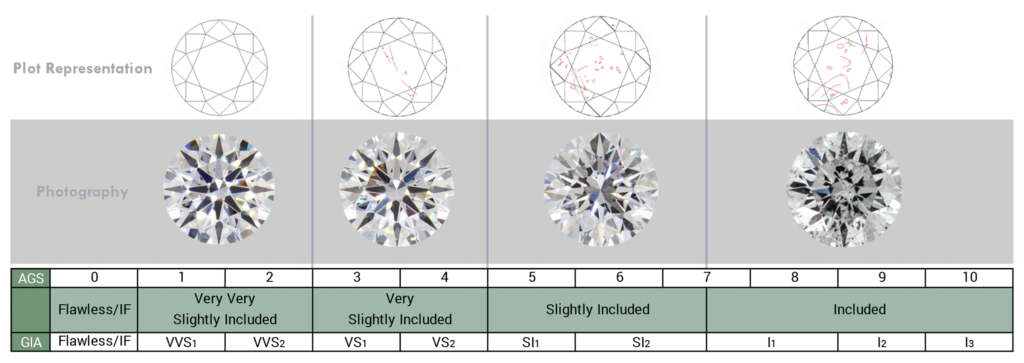Because our focus is always on protecting the consumer, we took the traditional GIA diamond scale one step further than the traditional scales, and added a numerical scale to correspond to the industry standard verbal descriptors, as a 0-10 scale.
We not only wanted to make sure our own practices were as meticulous as possible, we wanted to ensure that the scale was as easy to understand as possible. This extra step means that consumers can feel more confident than ever when making a jewelry investment.

When it comes to this special gemstone, there are various diamond levels to determine what the overall diamond clarity rating is.
AGS 0: Flawless or Internally Flawless
Flawless diamonds have no inclusions or blemishes visible under 10x. Internally Flawless diamonds have no inclusions visible under 10x, but can have very minor blemishes (marks and features confined to the surface only).
AGS 1 or 2: VVS
A diamond with a clarity grade of 1 or 2 (VVS1 or VVS2) has minute inclusions that are difficult for a skilled grader to see under 10x magnification.
AGS 3 or 4: VS
Very Slightly Included diamonds with a clarity grade of 3 or 4 (VS1 or VS2) have minor inclusions.
AGS 5, 6, or 7: SI
Slightly Included diamonds with a clarity grade of 5, 6, or 7 (SI1 or SI2) have noticeable inclusions that are fairly easy to see under 10x magnification. Sometimes, these inclusions can be visible to the unaided eye.
AGS (7, 8, 9, or 10): I
Included diamonds with a clarity grade of 7, 8, 9, or 10 (I1, I2, or I3), have inclusions that are obvious at 10x magnification. Sometimes, they can be seen with the naked eye. At the lower clarities, may have an effect on the diamond’s durability.
Overall clarity determinations are balanced between the diamond’s appearance face up in the loupe, the microscope at 10x, and eye visibility. Higher power is used to identify inclusions that are otherwise difficult to determine at 10x, which can often include VVS inclusions, however, the final grade is always determined at 10x, in four directions.
Factors that graders consider when determining a clarity grade include the size, nature, number, location, and relief of the inclusions. A diamond receives multiple opinions on the clarity grades it receives, so there is a consensus among expert graders as to what the appropriate grade should be.
AGSL also has implemented quality control mechanisms to ensure consistency in the diamond grading process.
There are five factors that affect how clarity is determined in a diamond, and how inclusions are considered; size, nature, number, location, and relief.
Inclusions closer to the girdle (further from the table) are generally more difficult to see, and if they are surface-reaching may be at risk for damage.
Inclusions that are positioned near the pavilion have the potential to reflect, as the pavilion facets can act as mirrors, reflecting the image of the inclusion.
Inclusions that are visible when focusing past the culet have less impact on the clarity grade. In addition, the shape, cutting proportions, and facet arrangement can affect clarity grade by obscuring or emphasizing clarity features.
Take a closer look at what buying a diamond entails or, find a certified AGS jeweler in your area to start the diamond buying process.
Copyright © 2024 American Gem Society